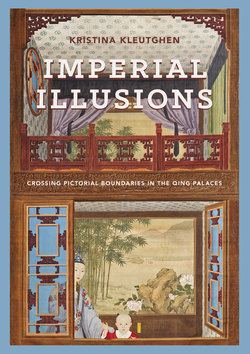Читать книгу Imperial Illusions - Kristina Kleutghen - Страница 73
На сайте Литреса книга снята с продажи.
ОглавлениеNotwithstanding his ignominious end, Nian’s official career of more than thirty years and his longstanding proximity to the court also enabled him to pursue his interests in Western objects and ideas, which may have developed during the six years he spent in Guangdong. Already during the Kangxi and Yongzheng reigns, Guangzhou was a major port of foreign entry into China, only becoming the sole foreign trade port in 1757 as a result of Qianlong’s imperial edict. French astronomer, geographer, and historian Antoine Gaubil, S.J. (Song Junrong, 1689–1759), wrote that while in Guangdong, Nian had purchased “many curious things for the Emperor out of the English ships,” suggesting that Nian had personal contact with the European objects arriving in China.16 In contrast to Yongzheng’s generally anti-Jesuit policies, he was personally fascinated by Western things, and increased both Western imports and the domestic production of occidentalizing goods during his reign. Among the approximately five hundred Guangzhou tribute lists detailing objects sent to the Yongzheng court, there is an unprecedented specific category just for Western imports (yanghuo, literally “ocean goods”).17 Building on the imperial workshops that Kangxi had founded to produce some of the most prized Western and Western-style goods in China, Yongzheng expanded the imperial glassworks, clockmaking workshop, and enamel painting workshop, and established a new imperial workshop to produce spectacles, a category of foreign object that particularly fascinated him.18 Even Giuseppe Castiglione’s earliest extant painting (Auspicious Objects [Juruitu], 1723, National Palace Museum, Taipei) dates from early in the first official year of the Yongzheng reign, demonstrating how Yongzheng made use of Western painting from the very start of his time as emperor. Despite his general rejection of the Jesuits, Yongzheng was clearly able to separate his distaste for the missionaries from his love of Western things, and while in Guangdong Nian Xiyao seems to have played an important role in fulfilling the emperor’s desires for such things that cannot be unrelated to the development of his own interests.
Nian carried these interests in Western things with him to Jingdezhen, where certain porcelains were decorated with “foreign colors” (yangcai, as the imported famille rose palette was known), while those incorporating Western designs, shading, and pictorial realism in their painted decoration became known as “Nian wares” (Nian yao). Nian himself seems to have been a reasonably gifted painter of traditional landscapes and of birds and flowers, but claimed that he could paint in Western styles as well.19 He published on a diverse range of technical subjects, including chronology and medicine, but Western mathematics was his most persistent interest and the one that came to define him.20 Letters written by Gaubil and Dominique Parrenin, S.J. (Ba Duoming, 1665–1741), consistently mention Nian in the context of mathematical and scientific discussions.21 Although his formal education is still only speculative, Nian was not a literati scholar-official who had studied the Confucian classics to pass the government examinations for a civil bureaucratic post; instead, he seems to have been a self-taught mathematician.22 In Biographies of Astronomers and Mathematicians (Chouren zhuan), which Ruan Yuan
